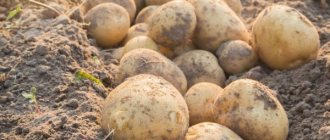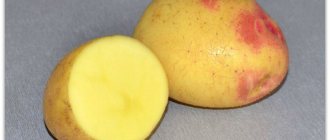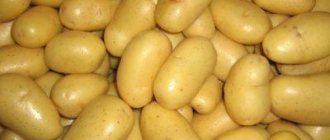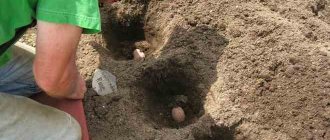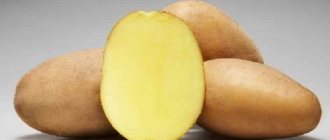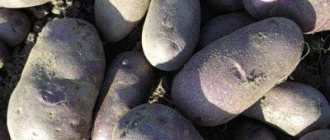Vegetable growing » Potatoes
0
1750
Article rating
Kira Stoletova
Rosalind potatoes belong to the category of industrial table varieties. Thanks to its taste and high yields, this type of tuber quickly gained popularity among gardeners and farmers all over the world.
Description of Rosalind potato variety
Description of the variety
Rosalind potatoes are the result of the work of German breeders. The variety was included in the state register of the Russian Federation in 2002 in the Central region, but was excluded in 2021 due to the refusal of the patent by the originator.
Pictured are Rosalind's potatoes.
The table summarizes the distinctive features of the variety.
| Indicators | Characteristic |
| Ripening period | 50-65 days |
| Bush | Tall, semi-erect, intermediate type |
| Number of tubers in a bush | 10-16 |
| Weight | 60-115 g |
| Form | Oval-rounded, with small superficial ocelli |
| Coloring | Red skin, yellow flesh |
| Leaves | Medium size, open type, green color |
| Corolla color | Red-violet |
| Starch content | 12-17% |
| Taste | Excellent (5 on a five-point scale) |
| Cooking class/group | B (medium crumbly) |
| Productivity | Average - 203-223 c/ha, maximum - 259 c/ha |
| Marketability | 89-94% |
| Keeping quality | 94% |
| Purpose | Dining room |
| Sustainability | To cancer, golden nematode and leafroll virus, wrinkled mosaic |
| Transportability | High |
Chemical composition
In the table you can see the vitamin and mineral composition of raw, unpeeled potatoes (per 100 g of product).
| Element | Content | Norm |
| Beta carotene | 0.001 mg | 5 mg |
| Vitamin B1 | 0.081 mg | 1.5 mg |
| Vitamin B2 | 0.032 mg | 1.8 mg |
| Vitamin B4 | 12.1 mg | 500 mg |
| Vitamin B5 | 0.295 mg | 5 mg |
| Vitamin B6 | 0.298 mg | 2 mg |
| Vitamin B9 | 15 mcg | 400 mcg |
| Vitamin C | 19.7 mg | 90 mg |
| Vitamin E | 0.01 mg | 15 mg |
| Vitamin K | 2 mcg | 120 mcg |
| Vitamin PP | 1.061 mg | 20 mg |
| Potassium | 425 mg | 2500 mg |
| Calcium | 12 mg | 1000 mg |
| Magnesium | 23 mg | 400 mg |
| Sodium | 6 mg | 1300 mg |
| Phosphorus | 57 mg | 800 mg |
| Iron | 0.81 mg | 18 mg |
| Manganese | 0.153 mg | 2 mg |
| Copper | 110 mcg | 1000 mcg |
| Selenium | 0.4 mcg | 55 mcg |
| Zinc | 0.3 mg | 12 mg |
Growing regions and climate requirements
The Rosalind variety is intended for cultivation in the following regions of the Russian Federation:
- Central;
- Volgo-Vyatsky;
- Central Black Earth;
- North Caucasian;
- East Siberian.
Features of care
"Rosalind" is a potato that is very responsive to high agricultural technology and can significantly increase productivity with proper care. If, with standard growing technology, at the first digging you can get a yield of about 100 c/ha, then good care increases these figures by at least 15-20%. The main measures should be aimed at weeding, increasing the air permeability of the soil through shallow loosening, as well as hilling in order to create the area necessary for the formation of tubers.
The lack of resistance of this variety to late blight infestation of both tubers and potato tops requires special attention to systematic preventive spraying, which can significantly reduce the risk of late blight at all stages of the growing season. For this purpose, it is recommended to use such chemical fungicidal agents as Fitosporin-M, Gamair, Ditan M-45, Acrobat MC, Metaxil, Alirin-B and Planriz.
Guided by the so-called “advice” of inexperienced potato growers or illiterate gardeners, novice vegetable growers very often delay the start of harvesting early varieties of potatoes, which negatively affects the quality and quantity of the harvest. These potato varieties should be harvested before mid-August. However, late blight, to which the Rosalind variety is susceptible, sometimes makes it necessary to harvest the crop earlier, and rains can, on the contrary, postpone harvesting for a very indefinite period.
https://fermoved.ru/kartofel/rozalind.html
https://dachadecor.ru/ogorod/kartofel-rozalind-sort-s-visokoy-i-druzhnoy-urozhaynostiu
Features of planting and growing
The culture is undemanding to the type and composition of the soil, but better results can be achieved when grown on light soils (sandy loam, loamy) rich in organic matter and minerals.
Planting care is traditional and involves moderate watering, loosening the beds, weeding, and fertilizing.
Preparing for landing
Germinating tubers before planting allows you to shorten the germination period and increase yield. The seed material is taken out of storage into the light, treated with disinfecting solutions with potassium permanganate, copper sulfate, “Fitosporin” and left in a bright room at a temperature above +14°C. Under such conditions, seedlings appear in about 14 days.
24 hours before planting, potatoes are soaked in growth stimulants “Epin”, “Zircon”, “Potain”, “Stimpo”, “Regoplant” according to the instructions on the package.
Soil requirements
The area chosen for planting potatoes is prepared in the fall. The soil is dug up, harrowed, loosened and humus added. In spring, the ground is sown with green manure plants: rye, lupine, peas, flax, wheat, oats.
After a month, the seedlings are mowed down and buried shallowly in the ground. Rotted plants loosen the soil, saturate it with oxygen and nutrients and inhibit the growth of pathogenic microflora.
Dates, scheme and rules of planting
The timing of planting depends on climatic and weather conditions. In the regions of the middle zone, planting work is carried out in early May, in the southern regions - at the end of April, in the northern regions - in mid-late May.
Prepared seeds are planted with seedlings upward to a depth of 8–10 cm with an interval of 30 cm. The distance between rows is 70 cm.
Holes for a shovel are formed on the site, a handful of wood ash and superphosphate is added to each. The top is covered with earth, the beds are leveled, but not compacted.
Interesting fact. The third US President, Thomas Jefferson, was the first to offer French fries as a treat to guests. The dish immediately became mega-popular.
Care
Rules for caring for potatoes:
- Watering . Rosalind responds gratefully to moderate watering, increasing productivity. In regions with a temperate climate, rainwater is sufficient; in the southern regions, plantings are watered manually or through a drip irrigation system once every 10–12 days. During drought, the frequency of watering is doubled.
- Mulching. Covering the beds with straw, hay, sawdust, and pine needles retains moisture in the soil and stops the growth of weeds.
- Loosening and weeding . The procedures are carried out without fail. The beds are loosened after each watering to prevent the formation of a hard crust. Weeding is carried out regularly, preventing weeds from taking root.
- Hilling. This is a standard potato care procedure that should not be neglected. The first hilling is carried out after the sprouts reach 10 cm, the second - after flowering.
- Feeding. Potatoes are fed with fertilizers with a minimum nitrogen content, with an emphasis on mineral compositions.
The table shows an approximate scheme for applying fertilizing.
| Application period | Top dressing | |
| I portion | During the period of green mass gain | A solution of chicken manure in a ratio of 1:15. Consumption per bush - 500 ml. |
| II portion | During the budding period | 10 g of superphosphate, 10 g of nitrate, 10 g of potassium sulfate per 10 liters of water. Consumption - 500 ml per bush. |
| III portion | During the flowering period (foliar) | 20 g of Mag-bor granules per 10 liters of water. Consumption - 5 liters per bush. |
Disease and pest control
Rosalind potatoes are susceptible to late blight of tops and tubers. The spread of the fungus is facilitated by excessive soil moisture and low air temperature. Timely preventive measures will help prevent infection:
- control of nitrogen levels in the soil;
- compliance with crop rotation rules;
- cleaning weeds and potato tops;
- disinfection of tubers in potassium permanganate, “Oxigumate”, “Fitosporin-M”;
- fertilizing with potassium and phosphorus;
- treatment of plants with Bordeaux mixture, whey with iodine.
At the first symptoms of infection, the potato tops are cut off and the bushes are sprayed with Oxychom, Ridomil, Gamair, Metaxil, Bravo, and Planriz. At the stage of tuber formation, the bushes are irrigated once with Alufit.
The fight against wireworms is carried out using:
- insecticides “Aktara”, “Bazudin”, “Prestige”, “Diazinon”, “Grom”, “Gromoboy”, “Zemlin”;
- adding onion peels to each well;
- watering the bushes with herbal infusion: 200 g of nettle, 100 g of dandelion and coltsfoot, 50 g of celandine per 5 liters of warm water - leave for 24 hours.
To destroy the Colorado potato beetle, which loves to crunch juicy potato tops, use the highly effective drug “Prestige”. It contains the fungicide pencycuron, the insecticide imidacloprid. The tubers are soaked in the prepared solution before planting.
Ladybugs and dragonflies are attracted to the site; beans, nasturtium, marigolds, and valerian are planted. According to gardeners, all this together is highly effective.
There is another interesting way to combat Colorado insects - their own poison contained in the bodies of insects. A jar with a capacity of 0.5 liters is completely filled with beetles and larvae, then poured into a 10 liter bucket, filled to the brim with water, tightly closed with a lid, and left for 4-7 days. The infusion is diluted with water in a ratio of 1:2 and sprayed on the plants.
Important! Wear rubber gloves and protective clothing.
Agricultural technology
The condition for obtaining a bountiful harvest is the correct choice of soil for potatoes. For a hybrid with a name consonant with the word “rose,” well-loose and naturally ventilated soils with a high moisture content are optimal.
At the preparatory stage, disinfection of not only the planting material itself, but also the soil under it, is organized. For this purpose, potato tubers are treated with special compounds like Colfugo Super. With their help, it is possible to protect future shoots from most garden diseases; treating the soil with “Force” or “Aktar”, for example, promotes their good germination.
Soil disinfectants are prepared in a proportion of 0.5 kilos per hundred square meters and help get rid of wireworms immediately after planting potatoes.
Important! When choosing a site, you should follow the rules of crop rotation, according to which the best predecessors of potato crops are legumes.
Planting procedures should begin at the end of the frost period, when the soil in the beds warms up to approximately + 5-8 degrees. During the planting process, potato rows are arranged along a line from north to south, holes are dug to a depth of 6-10 cm (at a distance of about 65-70 cm from one another). The distance between rows is maintained within 25-30 cm.
The correct choice of soil for potatoes is important
Caring for potatoes of this variety comes down to the following standard procedures:
- Weeding and shallow loosening (hilling).
- Moistening the soil (watering it).
- Fertilizer application.
When weeding and hilling a potato bush, the wet soil must be raked up to its tubers, which guarantees a good harvest.
Note! At the same time, the soil around the bush is saturated with oxygen, its drying slows down somewhat.
The first hilling is tied to the time of emergence, all subsequent hillings are carried out at intervals of approximately 3.5 weeks.
A mixture of peat and manure with the addition of a small dose of wood ash is used as organic matter. This composition is applied under the bushes several times (after the appearance of the first shoots, at the moment the buds open and three weeks before harvest).
In the first case, nitrogen-containing compounds are used, in the second, potassium and phosphorus are added to the soil. About 20 days before digging up the potatoes, they are fertilized with a mixture of slurry (25 ml) and superphosphate solution (30 grams per 10 liters of water).
Additional Information. Half a liter of nutrient mixture should be poured under each potato bush.
At the same time, organic fertilizers are introduced, which significantly improve the composition of the soil and somewhat loosen it.
Among the known diseases, the greatest danger is late blight, which damages not only the tubers of the plant, but also its above-ground part. The first signs of the disease can be judged by the appearance of dark spots on the leaves. To protect against it, it is recommended to use special chemicals (copper sulfate, in particular), sprayed evenly over the tops.
Related article: Potato variety “Mondeo” - description and photo
Collection, storage and use of crops
The first potato harvest is carried out in July. The tubers fully ripen at the end of August. The variety does not have high yields, but at the same time it has an attractive presentation.
The collected tubers are cleaned of soil and left to dry in the shade for 3-4 days. Then they are sorted, rejecting damaged ones with signs of rot.
The harvest is stored in the cellar at a temperature of +2...+3°C and air humidity of 70-80%. On a balcony or loggia, potatoes are stored in double boxes made of wood or plastic, which are inserted into each other. Foam plastic is placed in the gaps for insulation purposes.
Tubers can be stored in large boxes insulated with a foil screen. The container is placed on a hill so that the bottom does not touch the cold floor in winter.
In specialized stores, heated “balcony cellars” are presented to customers. They look like large hiking backpacks, are powered by electricity and can withstand temperatures down to -40°C.
Rosalind has a bright taste and attractive presentation due to its red peel and yellow pulp. The moderate starch content allows you to prepare boiled, fried, stewed, baked dishes from these potatoes. The tubers do not darken when cooked.
Advantages and disadvantages of the Rosalind potato variety
Rosalind has a number of advantages that distinguish it from other potato varieties:
- In warm regions, the harvest can be harvested twice if the first tubers are planted immediately after the snow melts, hilled up and covered if necessary.
- Potatoes quickly adapt to any soil and do not react to changing weather conditions.
- Practically does not suffer from potato nematode.
- The tubers ripen at the same time.
- By adjusting the cooking time, you can control the degree of friability of the potatoes.
- Pleasant taste.
- It grows well even with the most minimal care in the absence of hilling, loosening and watering, for example, in industrial conditions.
- Has high productivity.
- Thanks to the thick peel, the tubers are practically not damaged during assembly and transportation.
The disadvantages of the variety include the following:
- Rosalind is a tasty dish for wireworms, Colorado potato beetles and golden nematodes, so it is necessary to carry out preventive pest control measures in a timely manner.
- In too wet soil under not the most favorable conditions, potatoes often develop late blight.
Nuances of cultivation and possible difficulties
Even beginners do not have any difficulties when growing this variety. The plant adapts to any type of soil.
In addition to the traditional method of growing potatoes, the Dutch method is used. For planting, choose an area with a deep arable layer, since the tubers are planted to a depth of 10-15 cm. The first shoots are immediately earthed up. As soon as the shoots appear above the surface, the procedure is repeated.
The row spacing is 70-80 cm, the gap between holes is 25-35 cm.
Advantages of the method:
- The tubers are located above the soil level, since soil from the rows is used for hilling.
- The ridges receive enough solar heat and oxygen.
- During periods of prolonged rains, the bushes do not die from excess moisture, the water flows into the aisles.
- During drought, a sufficient amount of moisture is retained in the ridges.
Planting care is standard and includes watering, loosening, weeding, and fertilizing. To remove weeds, herbicides “Titus”, “Centurion”, “Lazurit” are used.
The area is watered three times a season: before flowering, 10 days after flowering.
Pests and diseases
The Rosalind variety, like many others, is not resistant to late blight. If during the first crop rotation the plants manage to “escape” the infection, then with a later planting this is not possible. In addition, in the summer an invasion of various pests is possible;
- aphid;
- Colorado potato beetles;
- wireworms;
- mole crickets;
- thrips and others.
To combat insects, you can use folk remedies or insecticides. For example, Rosalind potato bushes can be periodically dusted with ash, sprayed with infusion of garlic, chili pepper, mustard powder, and marigold decoction. Plantings can be mulched with straw, and fresh sawdust can be poured between the rows.
Summer residents also use effective insecticides:
- "Decis";
- "Fitoverm";
- "Agravertine";
- "Colorado";
- "Spark";
- "Confidor".
To prevent fungal diseases, the following measures must be taken:
- Do not plant tubers in an area where Solanaceae - potatoes, tomatoes, eggplant and others - grew last summer.
- Change the field every 3 years.
- Be sure to remove the tops immediately after digging up the potato tubers.
- Treat the seeds and treat the bushes with fungicides.
The main preventive measure to protect Rosalind potatoes from late blight is treatment with special preparations 1-2 times per season. To do this, use the following means:
- "Prestige";
- "Fitosporin";
- "Quadris";
- "Maksim";
- Bordeaux mixture (1% solution).
Advice! It is advisable to plant marigolds, calendula, coriander, fragrant tobacco and other plants that repel pests near the potato field.
Tips and reviews
Experienced gardeners speak positively about the Rosalind variety and share tips on growing it.
Taras, Pavlovsk : “I’ve been growing Rosalind potatoes for a long time. The variety is liked for its ease of care, long shelf life and the possibility of early harvesting. The tubers are all as picked, aligned, medium in size. When cooked, the skin does not crack and the flesh does not fall apart. I use bone meal for feeding. It supports flowering and promotes the rapid formation of tubers.”
Daria, Vyazma: “I’ve been planting Rosalind for three years in a row. I purchased the seeds from a local farmer and really liked the appearance. Caring for bushes is no different from caring for other varieties of potatoes. I prefer to plant the tubers not deeply - 5 cm deep, with the sprouts facing up. I know that potatoes like to breathe. I throw a few beans into the hole to stimulate plant growth and repel beetles.”
Pest treatment
Experienced farmers and gardeners advise carrying out the first treatment against pest invasion even before the Colorado potato beetle begins its invasion. It is best to do this two weeks after planting.
For spraying it is best to use such preparations as:
- Prestige - due to the fact that this product contains imidacloprid and pencicuron, it not only destroys pests, but also protects the plant from soil parasites and fungal diseases.
- Tabu is a relatively new drug. It has proven itself well as a means of protection against insect pests (wireworms, Colorado beetles).
- Aktara is the safest product for treating potato bushes. The drug quickly penetrates the leaves and stems of tuberous plants, making them poisonous to pests. But it does not affect the tubers themselves.
- Fitoverm belongs to the category of enteric contact preparations against pests. It is as safe as possible for the plant and can be used at any stage of crop growth.
This is not the entire list of effective remedies for the Colorado potato beetle. The gardener himself decides which product to choose based on the degree of infection of the bushes and the conditions in which the potatoes grow.
Potatoes are one of the most popular food products in Russia. There are many varieties of this crop, and each gardener has his own approach to planting and caring for it.
In order to ensure maximum yield, it is important not to make a mistake in choosing the right variety.
One of the most popular in agriculture is the Rosalind potato, bred by the German company Europlant, which has earned recognition from farmers around the world due to its delicious taste, high yield and ease of cultivation and subsequent storage.



